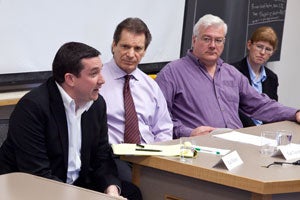It is imperative that governments uphold their obligation to ban cluster munitions absolutely, which is laid out in a treaty that more than 100 countries have joined, said a panel of disarmament experts in an HLS talk last week. Sponsored by the Harvard Law School Forum and the Harvard Human Rights Program, the panel described how the Convention on Cluster Munitions (CCM) was formed, and the challenges its advocates are facing despite its progress thus far.
Introducing the issue of cluster munitions, Lecturer on Law Bonnie Docherty of the Human Rights Program explained that weapons are indiscriminate, i.e. cannot distinguish between civilian and soldiers; moreover, they do not always explode on impact, meaning sub-munitions are spread out over a broad area like landmines for years. In light of these problems, the CCM, which was negotiated in 2007-2008, became internationally binding law in August 2010. Currently with 108 signatories and 57 state parties (the most recent being Costa Rica on April 28), the CCM is a good start to disarmament but there are many challenges yet to come, said Docherty.
Mark Hiznay, a senior researcher in the Arms Division at Human Rights Watch, expressed concern over the states like the United States, China and Russia that have not demonstrated intent to join the CCM. He said in this process, one must balance the humanitarian problems of cluster munitions with military priorities, but the focus tends to remain on the latter.
“The humanitarian voices are not being heard or responded to,” said Hiznay. “It’s the national security equities that are being pursued.”
He added that since non-signatory governments want to hold on their weapons for as long as they can, NGOs like Human Rights Watch will channel their efforts to working with politicians around the world on the issue.
“We need turn the heat up on these people to limit the damage that could happen,” he said.
Former Canadian diplomat and independent disarmament advocate Earl Turcotte discussed the need for universalizing the treaty and requiring party states to destroy stockpiled weapons, clean up contaminated areas, and provide risk reduction education to civilians. All these obligations, together with victim assistance, should be a matter of international cooperation, especially for nations who cannot meet them otherwise.
“It’s a sad reality that most cluster munitions have been used in developing countries,” said Turcotte. “They bear the lion share of the expense for clearance, stockpile destruction, and victim assistance.”
Turcotte also spoke strongly against the aiding and abetting of signatory party states to non-signatories in the use of cluster munitions.
 Lastly, Director of the U.S. Campaign to Ban Landmines Zach Hudson emphasized the importance of stigmatizing the use of cluster munitions and showing non-signatories that there are alternatives to these weapons. The ultimate goal of the process, he said, ” is to get the US to join the convention to ban all types of cluster munitions.”
Lastly, Director of the U.S. Campaign to Ban Landmines Zach Hudson emphasized the importance of stigmatizing the use of cluster munitions and showing non-signatories that there are alternatives to these weapons. The ultimate goal of the process, he said, ” is to get the US to join the convention to ban all types of cluster munitions.”
Stressing the importance of civil society involvement in the disarmament process, Hudson said citizens must show governments they care about the CCM, as they did the Mine Ban Treaty signed in 1997, which was a result of governments responding to a push by civil society to prohibit antipersonnel landmines around the world.
“Now the push is to get governments who are signatories already to push forward the ratification process and to push non-signatories to accede,” said Hudson.
“We need your help and everybody’s help to put pressure on government to understand that civil society wants this.”
– Joanne Wong
